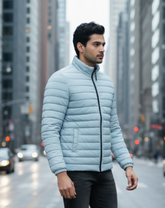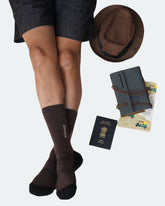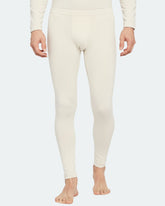An Interview With Endurance Athlete Kieren D’Souza Highlighting His Speed Climbing Achievement
How many of you are mountain climbing enthusiasts? For all those who are and for those who aspire to be, here's a post. Kieren D'Souza is an ultra-runner and endurance athlete.
In 2021, he scaled an incredible feat. The picture you see above mentions the ten peaks he scaled within 26 days. Well, yes, that's some achievement! It was part of “The Fastest Indian 6K” Project he undertook.
To honour that achievement, Yuktie Jhangiani, founder of Kosha had an interesting chat with speed climbing expert Kieren D'Souza.
Let's see what we can learn from Kieren's dedication and achievement. This post has excerpts from the 2021 interview with the athlete. Here's the entire interview in case you wish to watch it and get inspired:
The Athlete Talking About His Passion
To start off, Yuktie asks Kieren to shed light on the speed climbing concept and his inspiration behind this incredible achievement. That's when he shares his understanding of speed climbing along with an example of his previous climbs.
Kieren: "Speed climbing is essentially going up a mountain as fast as you possibly can and then coming down as fast as you possibly can."
As you read above, Kieren did a speed-climbing project in June 2021. The idea was to climb a minimum of ten 6000-metre-plus peaks within 30 days.
He did it within 26 days. He also climbed one mountain twice in the process. So essentially, the athlete climbed ten peaks in the 26 days.
The idea was brewing in his head way back in 2020 when he scaled Friendship Peak and Deo Tibba. He successfully went up these mountains and down in one push.
He had been dreaming about the 10-peak plan for many years. He also gives examples of fellow climbers setting out to achieve similar goals over the years.
Kieren also emphasizes the joy he gets by scaling such peaks and climbs. He speaks about how his urge to try new things has kept him going.
Yuktie also asks him about he felt after achieving the feat. We can all learn from what Kieran says in his reply.
"I trusted that I could pull it off in theory and just went with my belief in myself". But he also mentions that he found it pretty awesome, too, when he pulled off the 10th peak successfully.
He shares how excited he was while coming down from the 10th peak. He was jumping around with joy while he was with his friends.
Apart from the joy, he talks about his approach to achieving his goal. He treated this as a stepping stone in the natural order of progression. His constant urge of wanting to know "What Next?" seems to have been a boost.
The Training Routine for the Athlete
D'Souza mentions during the chat, "It's one thing building something up in your head and putting it on paper and theory and pulling it off."
"The biggest crux in the whole thing is usually fitness and acclimatization."
To pull off this incredible feat, you need suitable training, among other things. Kieren talks about how exercise and acclimatization play a role in enjoying a smooth mountain climb.
Yuktie asks him to share his training routine and the amount of years it took to get to this point.
Kieren speaks about how his 9-year experience as an ultra-runner helped him build up his base fitness for such climbs. He did his first 100 K run in 2012. This mileage and experience help him in all his climbing projects.
For the previous 4-5 years, he focused entirely on trail running to help him achieve his mountain climbing goals.
As for the other aspects of training, he did work on acclimatization. For Friendship Peak and the ten peaks, D'Souza didn't work on acclimatization.
But for Deo Tibba, the athlete spent a few days in the buildup doing acclimatization. He went up to a certain height of 5500 m.
For the ten peaks, here's what Kieren did. All you aspiring mountain climbing experts, you could follow suit too.
He first landed in Korzok. Then, the next day he went up to about 5800 metes. The following day, he went up to 6000 m, and that's it. He's done scaling his first peak. But there are a few things he had to do in the process:
- Check his blood saturation levels at different altitudes.
- Ensure to sleep and eat well.
Kieren says he was lucky not to have fallen ill during the climb and kept moving forward. You, too, must take note if you're planning a speed climb anytime soon. It's a crucial aspect to ensure that you stay healthy, fit and fine throughout.
The Challenges Faced by the Athlete
Nothing in life comes without challenges. And similarly, climbing also has its set of challenges. And the climbing expert Kieren, too, admitted that there were many things he came across that felt new to him.
He'd never done a project spanning a month anytime before. It seemed quite challenging to figure out the logistics and online information about the project. But along with the challenge, there came excitement too.
Kieren also shares an instance where he accidentally climbed the wrong mountain. He felt he was climbing the Shara Shuwa South, and he ended up climbing a different peak. He then came down the mountain and set out to scale the Shara Shuwa South.
In all this, his mind was never at rest. There was constant planning going on in his head. He had to be on his feet from one peak to another constantly. Hence, he didn't get much time to enjoy himself and had to make do with short-lived joys.
Kosha's Role in Climbing Expert Kieren's Successful Climbs
Next up, Yuktie also asks him about how he kept himself warm in varying temperature conditions. So he shared how the Kosha products he used were of great help to him.

He gave a special mention to the Thermal Wear for Men base layer at Kosha. Kieren used the example of his time in Lahaul. He would go for an early morning run at 7 a.m. in Lahaul. And often, he would have to run in -20 degrees.
At the time, he would layer up with the base layer. Along with that, he would wear a windproof or waterproof jacket.
He also highlights the versatility of the base layer in fluctuating temperatures. He used the layers throughout the ice climbing season in 2020. He carried the base layers along to Deo Tibba through the winters and during the ten peaks project.

And as part of their footwear, he used Woolen Socks for Men They proved to be very useful in supporting his mountaineering boots for the regular and ice climbs.
It shows how layering is effective in cold weather. It does play a massive role when you indulge in high-intensity sports.
The Changes Possible for the Next Adventure
Having achieved this incredible feat, Yuktie asks Kieren about the possible changes he can implement in his next challenge.
Kieren: "A lot would work differently first, for starters. I know the next project I want to work on and the physical skills and technical skills that I need to develop, so that would be one of my prime goals to get technically and physically a lot stronger for the project.
I would say technically more than physically because I want to be more confident about the technical knowledge that I have, whether it's the rope work."
The athlete emphasizes how he wanted to get used to the technical gear that was required. And he also treats it as a constant learning experience to develop his skills.
Planning logistics was another aspect he wants to improve upon. It plays a big role in letting everything flow smoothly.
Kieren: "It's a journey, so you will do something and then keep progressing."
When asked about suitable gear, he mentions how essential equipment is to your expeditions. He also gives his example in this case.
He wouldn't want to be stuck in extreme conditions with the wrong gear. And when you're mountain climbing, you should know these three things you'll come across:
- Bad Weather
- Tricky Situations
- Getting Stuck in a Nasty Place
It's not something you can have control over. But about gear, it's all on you. You must take the right calls for your safety.
If you invest in good gear, it also brings confidence. It could be a backpack, shoes or clothing. Also, comfort is vital for performance efficiency.
Importance of Preparation and Research
Preparation should always be specific to your goals and objectives. You need to work on your research skills for each adventure. Information always helps to prepare well.
You can read up and see the things you need or lack. It helps you to enhance the skills you need to develop and start working.
Kieren: "The way I approach is usually I break it down, and I work at the skill that I think is the biggest weak point of the whole chain for me. Then I work at the things following that."
Over time, Kieren has noticed that there's always going to be one weak link. But it's all part of a constant process.
He also emphasizes the mental aspect in this regard. He has been focusing on the mental aspect over the years.
Taking that forward, he suggests how you can work on your mental preparation.
Good training and preparation always benefit your mental confidence. He also feels you get some mental confidence when these aspects turn out well.
It's all about being honest about your strengths and weaknesses. Well, this can apply to real-life problems as well.
He's always brutally honest about his goals before starting a project.
"I've started breaking it down into smaller bits and pieces. Instead of thinking of Deo Tibba as one 20-hour outing, I have started thinking of it as a five-hour outing. So that is more reasonable for me to consume.”
So be honest and self-evaluate. You could also resort to simple breathing practices to calm yourself down.
Investing in Sport
Yuktie and Kieren also discuss how private investment can help grow the sporting industry.
Kieren: "The fact that you and me are having a conversation about this space because I function in it and your brand is functioning in the same space itself is progress for this ecosystem. Ten, or twenty years back, it was not the same.
Today we're sitting, and people like me and you are functioning in this space." He also talks about having an athletic point of view if you're an athlete.
"And I honestly think the best way forward is having the opportunity to push ourselves hard on a global level. We do need infrastructure, which is immense."
You also need good role models to push yourself in that direction. But he also speaks of how an athlete in the outdoor space would benefit from going abroad in the current scenario.
"Every sport out there has a competitive angle to it. We all are progressing in that direction, but it's slow."
Conclusion
I hope this post has motivated you and taught you many things. Kieren's attitude and approach to life and sport are praiseworthy.
So when are you planning your next expedition?
This post was written by Kosha team member - Shawn Mathias
Editor’s Picks
Packable Puffer Jacket For Men
- From ₹3,900.00
₹8,400.00- From ₹3,900.00
- Unit price
- / per
Men's Full Sleeves Thermal | Merino Wool + Bamboo
- ₹4,940.00
₹7,600.00- ₹4,940.00
- Unit price
- / per
Alaskan Parka Jacket For Women - Slim Fit
- ₹8,925.00
₹11,900.00- ₹8,925.00
- Unit price
- / per
Lightweight Packable Puffer Jacket For Women
- ₹5,040.00
₹8,400.00- ₹5,040.00
- Unit price
- / per
Men's Merino Wool Cushioned Technical Socks
- ₹1,074.00
₹1,790.00- ₹1,074.00
- Unit price
- / per













